Gardening with children is a great way to teach them about nature and promote a healthy lifestyle. To get started, you need a solid gardening set up. Whether you’re a seasoned gardener or just starting out, this ultimate gardening set up guide will provide you with useful tips and information on how to plan, set up, and maintain a beautiful garden.
Key Takeaways:
- Teaching children about gardening can lead to improved physical and emotional health and cognitive development.
- A gardening set up involves planning, selecting the right tools and equipment, deciding on a garden layout, preparing and maintaining the soil, planting and caring for your plants, and dealing with pests and diseases.
- Choosing the right seeds, designing a functional garden layout, and maintaining healthy soil are key elements of successful gardening.
Understanding the Basics of Gardening Set Up
To create a successful garden, it is important to start with a well-thought-out plan. Planning a garden involves several crucial steps, including selecting the right location, determining soil quality, and deciding on the garden layout.
Whether you are starting a new garden or revamping an existing one, the first step is selecting the right location. Look for an area that receives at least six hours of sunlight per day and has good drainage. Make sure the site is easily accessible and has enough space to accommodate your garden layout.
After selecting the location, you need to determine soil quality. Conduct a soil test to check for nutrient deficiencies and pH levels. Based on the results, you may need to add organic matter or adjust the pH level to create a suitable growing environment for your plants.
Next, consider the garden layout. There are several different layouts to choose from, including raised beds, container gardens, and traditional in-ground gardens. The layout you choose will depend on your space, budget, and personal preferences.
When planning your garden, it is also important to consider the types of plants you want to grow. Determine which plants are suitable for your climate and soil conditions. Research the best time to plant each type of plant and plan your planting schedule accordingly.
By following these steps, you can create a well-planned garden setup that provides a healthy and thriving environment for your plants.
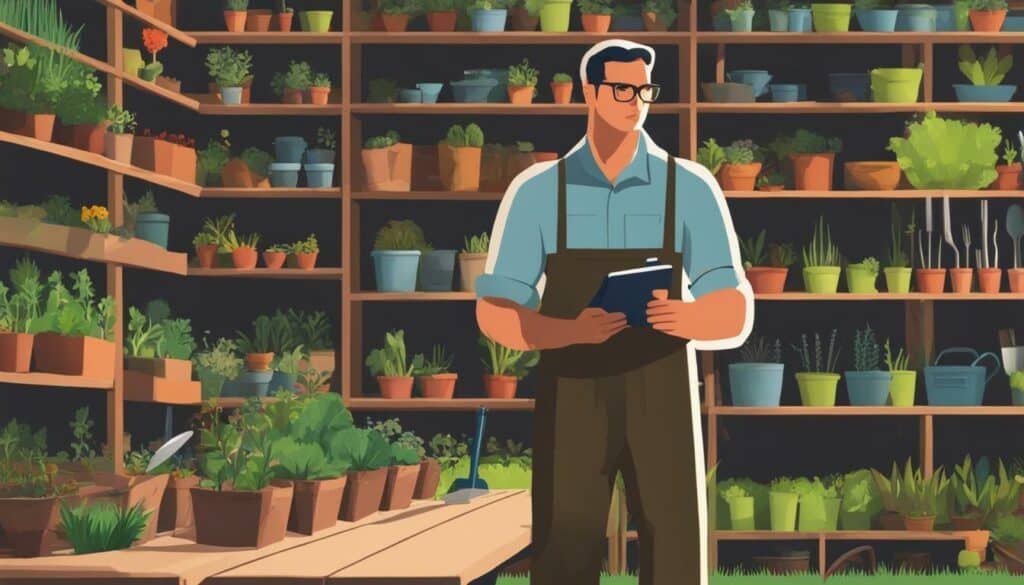
Essential Tools and Equipment for Your Garden
Having the right tools and equipment is crucial for efficient and enjoyable gardening. There are several essential tools and equipment that every gardener should have. Gardening can be a fun and rewarding activity, but having the right tools can make all the difference. Here are some of the essential tools and equipment for your garden:
| Tool/Equipment | Description |
|---|---|
| Hand Trowel | A small, handheld tool that is used for digging small holes, transplanting seedlings, and weeding. It is a versatile tool that every gardener should have in their arsenal. |
| Pruning Shears | Used for cutting and shaping plants, pruning shears can be used to trim branches, remove dead or diseased wood, and shape plants for aesthetic purposes. Investing in a good pair of pruning shears will make your gardening tasks much easier. |
| Garden Gloves | Essential for protecting your hands while working in the garden, garden gloves can help prevent blisters, cuts, and scratches, as well as protect your hands from thorns and thistles. Look for gloves that are durable, breathable, and fit well. |
| Watering Can or Hose | Proper watering is essential for the health and growth of your plants. Depending on the size of your garden, you may opt for a watering can or a hose with a spray nozzle. Make sure to water your plants deeply and evenly to promote healthy root growth. |
| Garden Fork | A valuable tool for aerating soil, turning compost, and breaking up compacted dirt, a garden fork can also be used for lifting and dividing plants. Look for a sturdy garden fork with sharp tines for maximum efficiency. |
| Rake | Useful for various garden tasks, such as removing leaves, weeds, and debris from your garden beds, a rake can also be used for leveling soil and spreading mulch. Look for a rake with sturdy tines and a comfortable handle. |
| Garden Hoe | Designed for cutting through roots, chopping weeds, and cultivating soil, a garden hoe is a versatile tool that can be used for preparing planting beds, digging trenches, and mixing in soil amendments. Choose a garden hoe with a sharp blade and a comfortable handle. |
| Wheelbarrow or Garden Cart | If you have a large garden or frequently move heavy materials, a wheelbarrow or garden cart is a must-have tool. It can be used for transporting soil, mulch, plants, and other materials around your garden. Look for a wheelbarrow or garden cart with sturdy construction and large capacity. |
These are just a few examples of the essential tools and equipment for your garden. Depending on the size and type of your garden, you may need additional tools such as a garden spade, garden knife, or weed trimmer. Remember to invest in high-quality tools that are comfortable to use and built to last. With the right tools, you can enjoy a successful and fulfilling gardening experience.
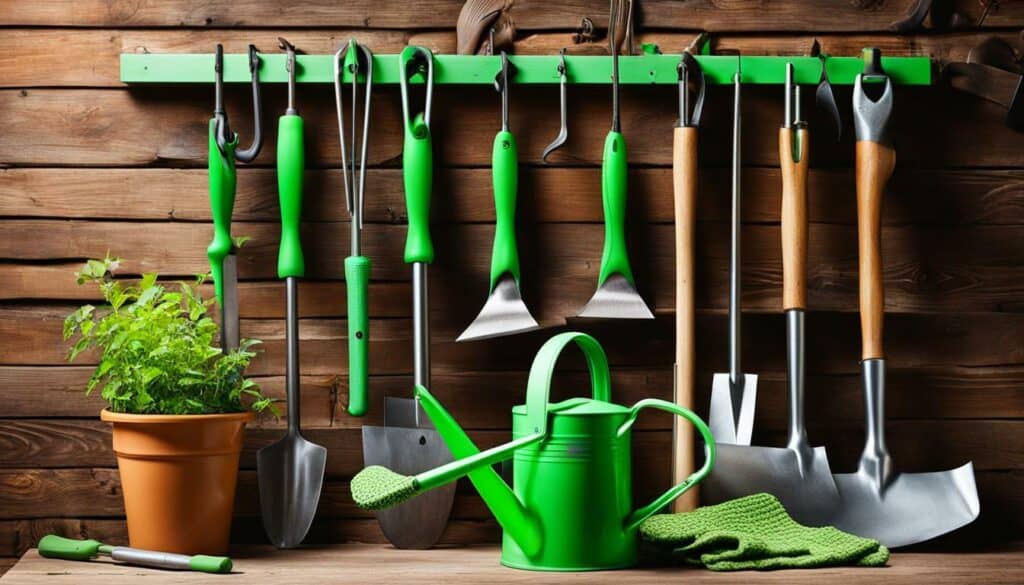
Selecting the Perfect Seeds for Your Garden
The success of your garden starts with selecting the right seeds. When creating a garden space, it is important to consider your specific needs and preferences. Are you looking for a certain vegetable or fruit to grow? Do you want a garden that attracts pollinators or one that is easy to maintain? Answering these questions will help you determine what types of seeds to choose.
If you are gardening with children, involving them in the seed selection process can be a fun and educational experience. Planting seeds, watering, weeding, and harvesting can teach kids life skills and foster a love for nature. Gardening with children promotes physical activity and a connection to the environment, making it a rewarding experience for all involved.
It is crucial to build relationships with people who can help you in your gardening journey. Mr. Owita from Kenya is one such person who can provide valuable knowledge and guidance. In Carol Wall’s memoir about her friendship with Mr. Owita, she learns the importance of accepting change and finding beauty in fleeting moments, similar to the beauty that can be found in a garden.
However, it is important to approach gardening with a realistic mindset and not expect profound results immediately. Personal growth and experience take time, and it is important to be honest with yourself and open to learning and experimentation. With the right mindset and resources, gardening can be a fulfilling and enjoyable activity.
When selecting seeds for your garden, consider factors such as climate, sunlight, and soil conditions. Some seeds may be better suited for certain environments, and it is important to do your research on the specific needs of your desired plants. Don’t be afraid to try new seeds and experiment with different varieties to find what works best for your garden.
In conclusion, selecting the perfect seeds for your garden requires careful consideration of your goals, the needs of your plants, and the resources available to you. With the right mindset and knowledge, you can create a successful and thriving garden that brings joy and beauty to your life.
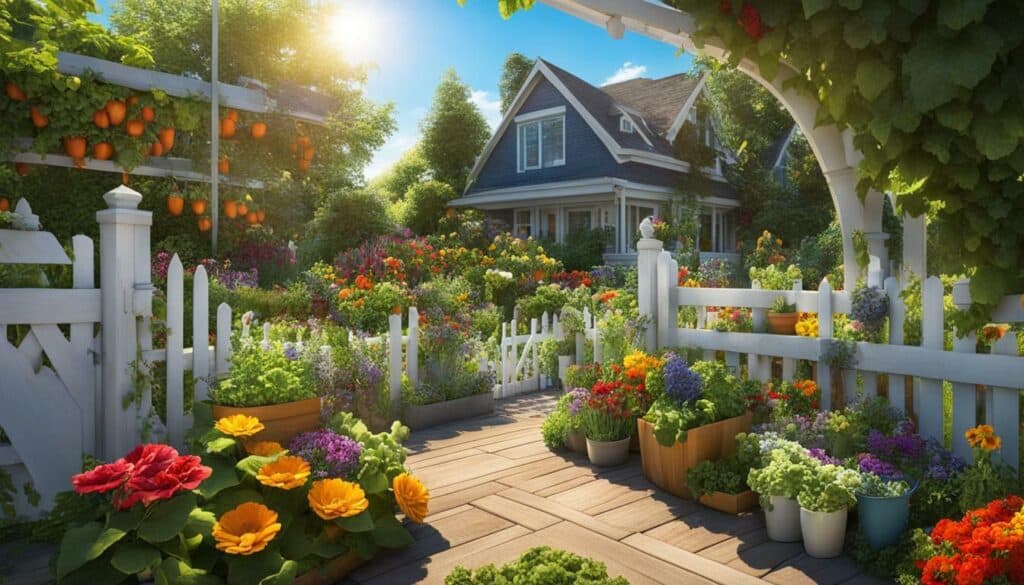
Creating a Functional Garden Layout
Designing a functional garden layout is essential for a well-organized and visually pleasing space. A properly designed garden not only enhances the aesthetics of your outdoor space but also improves the functionality of your garden. Whether you have a large or small area to work with, designing a garden layout that maximizes space, accessibility, and aesthetics is vital.
When establishing a garden, it is crucial to consider the purpose of the garden. Will it be a peaceful retreat from the hustle and bustle of daily life, a play area for children, or a space to grow fruits and vegetables? A well-designed garden can serve multiple purposes depending on your needs and interests.
When designing a garden layout, it is important to consider the various elements that make up a garden such as plant placement, garden paths, seating areas, and garden structures. The placement of plants should be based on the type of plants and their specific needs, including sunlight exposure and soil quality.
Garden paths should be wide enough for easy movement and accessibility and can be made from materials such as gravel, pavers, or flagstone. Seating areas can be incorporated into the garden design to provide a place for relaxation and enjoyment, such as a bench or a garden swing.
Garden structures such as trellises, arbors, or pergolas can be used to add height and interest to your garden design. They can also provide a support structure for climbing plants and vines, maximizing vertical space and creating a visually stunning effect.
Designing a garden layout can be a fun and creative process, and there are many resources available for inspiration and guidance. Utilizing a garden planning tool or app can help you visualize the garden layout and experiment with different designs before committing to a specific plan. Gardening books and magazines can also provide valuable ideas and tips for garden design.
Overall, creating a functional garden layout is a crucial part of establishing a successful garden. By considering the purpose of the garden and incorporating elements such as plant placement, garden paths, seating areas, and garden structures, you can create a visually stunning and functional garden that meets your needs and interests.
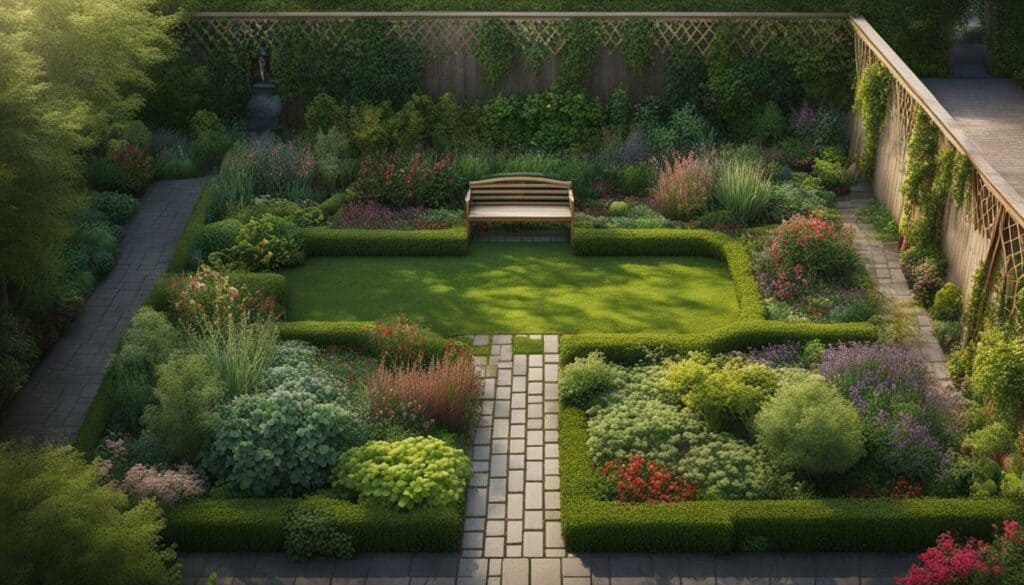
Preparing and Maintaining the Soil
Good soil is the foundation for a thriving garden. Before planting anything, it’s essential to assess and prepare the soil to ensure optimal growing conditions for your plants. Here are some garden setup tips and gardening ideas to help you establish healthy soil:
Assess Your Soil
The first step in preparing the soil is to assess its quality. You can do this by conducting a soil test, which will determine the pH level and nutrient content of your soil. Knowing these factors will help you determine which amendments, such as lime or fertilizers, your soil needs to support healthy plant growth.
Improve Your Soil’s Texture
Soil texture affects how well plants can absorb nutrients and water. You can improve soil texture in several ways, such as adding organic matter, which makes soil more porous and allows for better water retention. Composting your kitchen and yard waste is an excellent way to add organic matter to your soil.
Manage Soil Moisture
Plants require adequate moisture to grow, but too much water can be detrimental to their health. Properly managing soil moisture involves striking a balance between providing enough water without causing waterlogging. Using a mulch layer around plants can help regulate soil moisture by reducing evaporation and suppressing weed growth.
Fertilize Your Soil
Fertilization is an essential aspect of soil preparation. Plants require different nutrients to grow, including nitrogen, phosphorus, and potassium. You can use organic or synthetic fertilizers to replenish the soil’s nutrient content and promote healthy plant growth. However, it is important to follow recommended application rates as over-fertilization can lead to nutrient burn or runoff pollution.
Following these garden setup tips and gardening ideas for preparing and maintaining the soil will set you up for a successful gardening experience and provide you with a sense of fulfillment and satisfaction as you watch your plants grow and thrive.
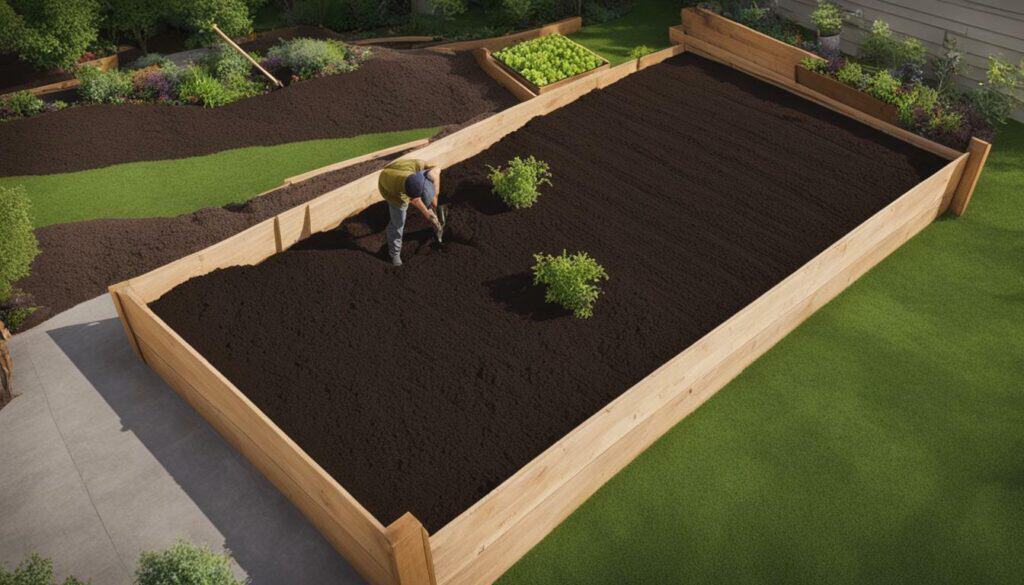
Planting and Caring for Your Garden
Once your garden is set up, it’s time to start planting and nurturing your plants. Gardening is a rewarding activity that requires patience, care, and attention to detail. Whether you’re growing vegetables, fruits, flowers, or herbs, each plant has specific needs that must be met to ensure its growth and health.
Gardening can be a fun and educational experience, especially for children. Involving kids in gardening activities can provide hands-on learning experiences and foster a love for nature. Planting seeds, watering, weeding, and harvesting can teach children about where their food comes from and promote a healthy lifestyle. Plus, gardening can have a positive impact on physical health, emotional well-being, and cognitive development.
If you’re new to gardening, starting with easy-to-grow plants like tomatoes, basil, or sunflowers can provide a sense of accomplishment and boost your confidence. As you gain more experience, you can experiment with different varieties and techniques.
When planting your garden, it’s important to follow the instructions on the seed packet or plant label. This will provide information on the type of soil, amount of sunlight, and spacing requirements for each plant. Be sure to plant each seed or seedling at the correct depth and water them well.
Regular watering is essential for the health and growth of your plants. Most plants need about an inch of water per week, either from rainfall or irrigation. Be sure to water the soil, not the leaves, to prevent disease and conserve water. Mulching can also help retain moisture and suppress weeds.
Pruning and maintenance are also important for a thriving garden. Removing dead or diseased plant parts can prevent the spread of disease and improve the appearance of your garden. Fertilizing can also provide essential nutrients for growth, but be careful not to over-fertilize, which can damage your plants.
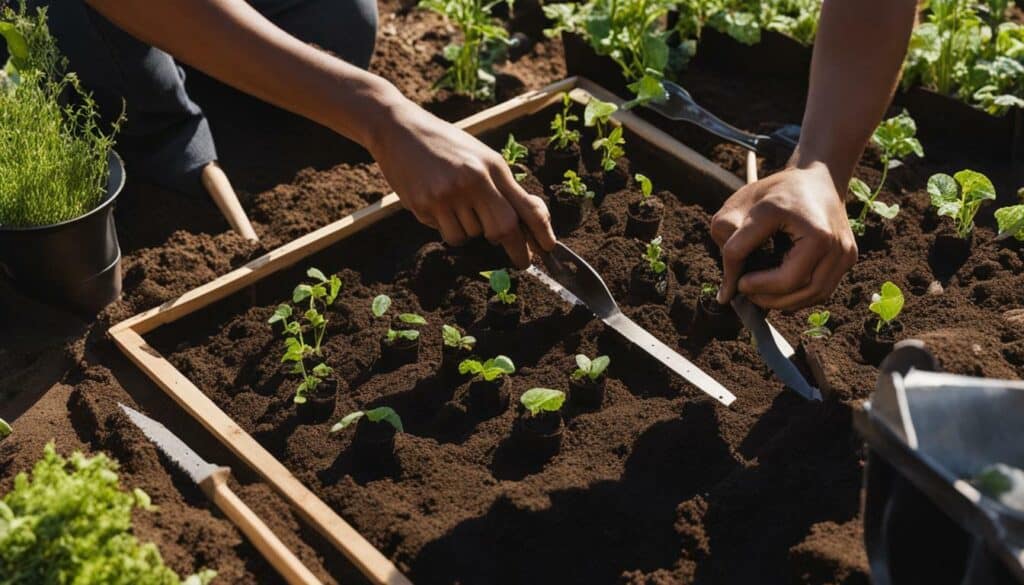
Gardening can be a source of friendship and personal growth, as highlighted in the memoir “Mister Owita’s Guide to Gardening”. The book explores the transformative power of friendship through the unlikely bond between a well-to-do white woman and an impoverished Kenyan immigrant who helps her transform her garden. Gardening can bring joy, beauty, and a deeper understanding of the world around us.
Next, we’ll explore how to deal with pests and diseases that may affect your garden.
Dealing with Pests and Diseases
Protecting your garden from pests and diseases is an important part of maintaining a thriving landscape. Fortunately, there are several garden setup tips and gardening tools and equipment that can help you prevent and control these issues.
| Method | Description |
|---|---|
| Using Organic Insecticides | Many organic insecticides, such as neem oil, garlic spray, and insecticidal soap, are effective at controlling pests without harming beneficial insects. |
| Practicing Crop Rotation | Rotate your crops each season to prevent pests and diseases from building up in the soil. This also helps to maintain soil fertility. |
| Maintaining Proper Hygiene | Clean up garden debris regularly and remove any diseased plants to prevent the spread of diseases. |
| Regular Inspection | Check your plants regularly for signs of pests or diseases, such as holes in leaves or discolored patches. Take prompt action to prevent further damage. |
While prevention and control of pests and diseases is essential, it is important to approach it in a responsible and eco-friendly way. Avoid using chemical pesticides unless absolutely necessary, as they can harm beneficial insects and pollinators. Instead, consider using organic methods and products, or consult with a professional for advice on safe and effective measures.

In conclusion, dealing with pests and diseases is a critical part of gardening setup. By following these tips and taking the necessary precautions, gardeners can protect their plants and enjoy a healthy and abundant harvest.
Harvesting the Fruits of Your Labor
After months of hard work, it’s time to reap the rewards of your garden. Harvesting is one of the most exciting and satisfying parts of gardening. Nothing compares to the feeling of picking your own fresh fruits, vegetables, and herbs, knowing that you grew them from scratch. Here are some gardening ideas and tips for successful harvesting:
- Start by checking your plants regularly to identify when they are ready for harvesting. Each plant has its own timeline for maturity, so be sure to research the specific plants you are growing to determine when to harvest.
- Harvest in the morning when the plants are the freshest and have the highest water content. This ensures maximum flavor and nutrients.
- Use sharp scissors or pruning shears to avoid damaging the plant and ensure a clean cut.
- Be gentle with your plants when harvesting to avoid accidentally pulling them out of the soil or breaking branches.
Establishing a garden is a great way to spend quality time with family and friends. Gardening with children is an excellent way to teach them about the environment and sustainable living while also promoting physical activity and healthy eating habits. For children, harvesting can be a fun and exciting activity that helps them appreciate the fruits of their labor and encourages them to eat more fruits and vegetables.
“Mister Owita’s Guide to Gardening” is a heartwarming book that chronicles the unlikely friendship between a white woman and an immigrant gardener from Kenya. Through their shared love of gardening, they both find solace and growth in the face of personal challenges. The book highlights the importance of resilience, vulnerability, and the beauty in small moments.
Once you’ve harvested your fruits and vegetables, you can store them in a cool, dry place, such as a pantry or refrigerator. Some produce, like tomatoes or avocados, can be left on the countertop to ripen. You can also freeze or can your fruits and veggies for later use. Be sure to research the proper storage techniques for each type of produce to ensure maximum freshness and flavor.
Establishing a garden is a fulfilling and rewarding experience. With the right tools, equipment, and knowledge, anyone can create a beautiful and functional garden space. Harvesting the fruits of your labor is a wonderful way to celebrate your hard work and dedication. So get outside, get your hands dirty, and enjoy the bountiful harvest of your garden!
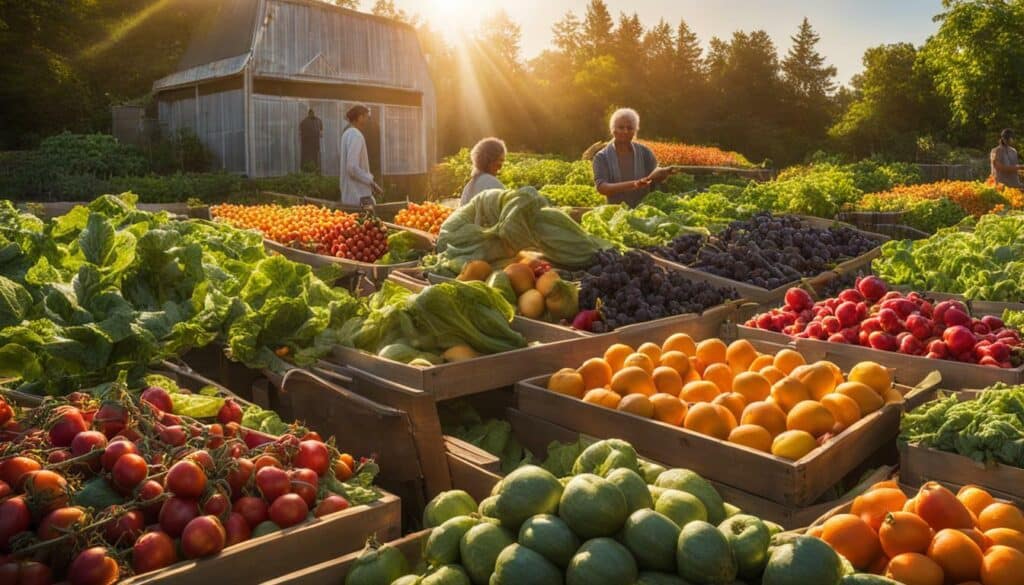
Conclusion
Overall, gardening can be a fulfilling and enriching activity for people of all ages. Whether you’re a seasoned gardener or just starting out, mastering your gardening set up is essential for a successful and enjoyable experience. By understanding the basics of gardening set up, selecting the perfect seeds, creating a functional garden layout, preparing and maintaining the soil, planting and caring for your garden, and dealing with pests and diseases, you can ensure the health and growth of your garden.
Gardening offers numerous benefits, including improved physical health, enhanced emotional well-being, and boosted cognitive development. It also provides an opportunity to connect with nature and learn valuable life lessons. The memoir “Mister Owita’s Guide to Gardening” is a heartwarming tale that emphasizes the importance of friendship, kindness, and personal growth. However, it may not be to everyone’s taste and some readers found the pacing of the book to be disjointed.
Overall, gardening and friendship can have a profound impact on one’s life. So go ahead and start your garden today, and see how it can enrich your life!
FAQ
Q: What are the benefits of gardening with children?
A: Gardening with children teaches them about nature, promotes a healthy lifestyle, and develops cognitive, physical, and emotional skills.
Q: What is the book “Mister Owita’s Guide to Gardening” about?
A: “Mister Owita’s Guide to Gardening” is a memoir that tells the story of an unlikely friendship between a woman and a Kenyan gardener, highlighting the transformative power of gardening.
Q: How was the book “Mister Owita’s Guide to Gardening” received?
A: The book received mixed reviews, with some readers finding it unrealistic and lacking depth.
Q: Is gardening suitable for people of all ages?
A: Yes, gardening can be a fulfilling and enriching activity for people of all ages.
How Can I Use the Ultimate Gardening Set-Up Guide to Master My Green Thumb?
Learn how to master your green thumb with the ultimate gardening set-up guide. These green thumb gardening guides provide valuable tips and advice for creating the perfect gardening environment. From selecting the right tools to understanding soil composition, this comprehensive guide will help you achieve gardening success. Whether you’re a beginner or experienced gardener, unlocking the secrets of a green thumb has never been easier.
Source Links
- https://thefunmaster.com/unleash-your-childs-green-thumb-the-ultimate-guide-to-gardening-fun-with-kids/
- https://www.amazon.com/Mister-Owitas-Guide-Gardening-Unexpected/dp/0399157980
- https://www.amazon.com/Mister-Owitas-Guide-Gardening-Unexpected/dp/0425273830
- https://www.shape.com/lifestyle/mind-and-body/find-your-green-thumb-first-time-gardening-tips
- https://www.onegreenplanet.org/lifestyle/how-to-find-your-green-thumb-and-start-a-garden/
- https://www.almanac.com/vegetable-gardening-for-beginners
- https://www.gardendesign.com/how-to/
- https://www.gardeningknowhow.com/garden-how-to/info/beginners-guide-to-gardening.htm
- https://www.almanac.com/gardening-tools-guide
- https://www.melaniejadedesign.com/15-must-have-gardening-tools/
- https://www.washingtonpost.com/home/2023/02/28/essential-garden-tools/
- https://www.forbes.com/sites/nomanazish/2022/08/31/how-to-choose-the-best-seeds-for-your-vegetable-garden-according-to-gardening-pros/?sh=24ad645e34ef
- https://www.bhg.com/gardening/design/projects/guide-to-buying-seeds/
- https://www.growforagecookferment.com/how-to-choose-the-right-seeds-for-your-garden/
- https://gardeningsolutions.ifas.ufl.edu/plants/edibles/vegetables/designing-your-vegetable-garden.html
- https://www.almanac.com/over-20-vegetable-garden-layout-ideas
- https://plantperfect.com/how-to-design-the-perfect-vegetable-garden-layout/
- https://www.almanac.com/soil-preparation-how-do-you-prepare-garden-soil-planting
- https://www.southernliving.com/garden/how-to-prepare-garden-soil-for-planting
- https://www.planetnatural.com/garden-soil/
- https://commonsensehome.com/start-a-garden/
- https://growinginthegarden.com/gardening-for-beginners-how-to-start-a-garden-in-8-simple-steps/
- https://www.bhg.com/gardening/pests/insects-diseases-weeds/garden-pest-control/
- https://kidsgardening.org/resources/gardening-basics-dealing-with-garden-pests-and-diseases/
- https://www.gardeners.com/how-to/managing-garden-pests-diseases/5064.html
- https://www.gardencityharvest.org/the-real-dirt-garden-city-harvest-blog/2015/08/05/enjoy-the-fruits-of-your-labor-harvesting-basics
- https://cottageatthecrossroads.com/enjoying-the-fruits-of-our-labor/
- https://www.sandiegouniontribune.com/lifestyle/home-and-garden/story/2020-07-11/garden-mastery-enjoy-the-fruits-and-the-vegetables-of-your-labor
- https://growingourown.wordpress.com/6-conclusion/
- https://www.daleharvey.com/in-the-garden/articles-of-interest/PACIFIC STEEL SUTTON PARK/Sutton Park Primary School Gardening Project/Page 5 – Conclusion.html
- https://www.ncbi.nlm.nih.gov/books/NBK373975/





Leave a Reply